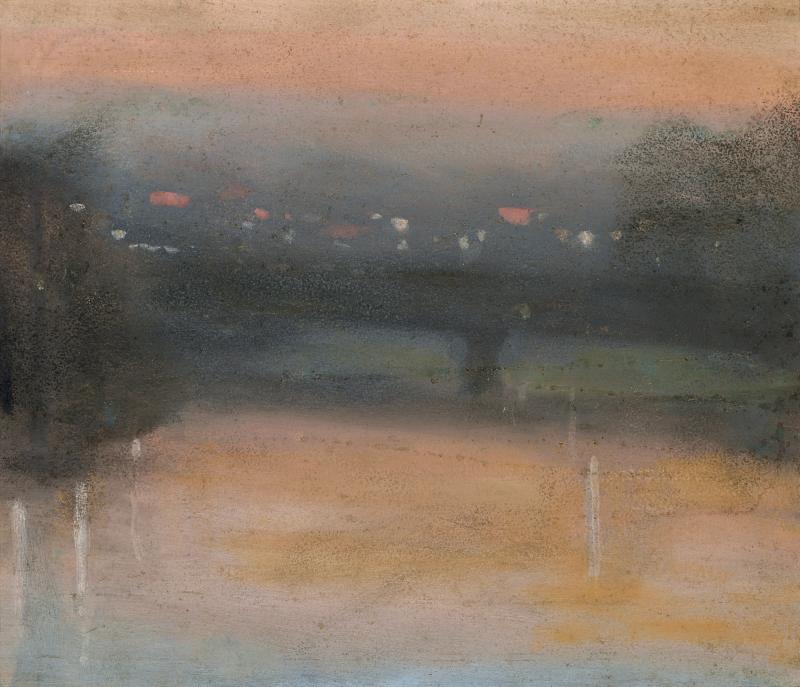CLARICE BECKETT (1887-1935)
Bridge over the Yarra (Punt Road Bridge) c1924
Estimate: $80000 - 120000
Sold For:
$100000 hammer
$122727 inc. buyer's premium
Description
CLARICE BECKETT (1887-1935)
Bridge over the Yarra (Punt Road Bridge) c1924
oil on board
28.5 x 33.5 cm; 42.5 x 47.5 cm (framed)
Provenance:
Hilda Mangan (the artist's sister), Melbourne
Rosalind Humphries Galleries, Melbourne, 1973
Private collection, Melbourne
Thence by descent, private collection, Melbourne
Exhibited:
Clarice Beckett, Rosalind Humphries Galleries, Melbourne, 1973, cat.11
Estimate: $80000 - 120000
Result Hammer: $100000
The insignificant is as big to me as any. What is less or more than a touch?1
In 1979, art historian and curator Rosalind Hollinrake noted that Clarice Beckett owned a copy of Walt Whitman’s Leaves of Grass and had underlined this passage. They are simple but poignant words epitomising the essence of Beckett’s beautiful observations of everyday moments in life and nature, and her rising status as arguably the most recognised style of a female Melbourne artist of the 1920s and 30s.
Clarice Beckett’s works now command the respect they were denied during her lifetime. The subject of two recent major retrospective exhibitions (Art Gallery of South Australia and Geelong Art Gallery) Beckett has become recognised as a trailblazer for female artists, something unbeknownst to her at the time. Beckett refrained from compromising under the heat of dominating male criticisms, developing her own unique style and continuing to exhibit with The Twenty Melbourne Painters and hold solo exhibitions at The Athenaeum Gallery throughout her career.
Born into a middle-class family and developing a taste for literature and the arts, Beckett spent her time absorbed in poetry, theosophy and drawing. While not being as socially inclined as her sister, Hilda, Beckett often suffered from the mistaken perception that she was demure, even withdrawn. In 1914, at the age of 27, she finally convinced her parents to let her undertake formal art training for three years at the National Gallery School under Frederick McCubbin (1855-1917). Beckett pursued a fourth year under Max Meldrum (1875-1955) at his newly opened school where she would be greatly influenced by Meldrum’s belief that painting could reveal the appearance of an object, reflected by light applied through tonal application. The shifting qualities of light throughout any one given day would become a cornerstone for Beckett’s works. Further encouragement from friends such as Alex Colquhoun (1862-1941) would see Beckett develop a style that, ‘surrendered to the sensory impressions of her suburban world with such intensity that the force of her observations created an entirely new visual language.’2
Beckett would often return to favourite locations at different times of day, travelling with her innovative mobile painting trolley and easel, capturing everyday moments. Misty mornings along Beach Road, hazy summer days at Beaumaris beach, foggy lights along St Kilda Road, Beckett was content to paint her surrounds more than once, with each work having its own point of difference. When considered as a whole, Beckett’s artworks capture a fleeting moment in time, when life was less hurried. Each work held its own place and she often juxtaposed previously exhibited works with new ones on a similar theme to create a visual resonance between them.
As with Bridge over the Yarra (Punt Road Bridge), Beckett would paint this scene and close by surrounds from different perspectives several times. While other works from the same period often take a closer viewpoint and include minor suggestions of details, such as Princes Bridge c1923, the work Bridge over the Yarra (Punt Road Bridge) is the epitome of her mastery of subtle nuances and deft brush strokes. The dark horizontal line of the bridge anchors the work. The misty purple, pinks and apricots from the setting sun are reflected in the waters of the Yarra River, hinting at the coming twilight hour. Streetlights along the bridge blink through the haze alongside the river bank, reminiscent of James Whistler’s famous nocturnes of the late 1800s.
Although painted several years later, Across the Yarra c1931 (Figure 2) can be viewed as a companion piece to the nocturnal Bridge over the Yarra (Punt Road Bridge). Again, painted from the banks of the Yarra, we glimpse a twilight view of the opposite bank, shrouded in evening mist. The stillness in the air is palpable and the lights emanating from the opposite bankside road and buildings shimmer in the fog. The winter chill is evident in the bare tree on the right, a companion evergreen keeps it company. Underneath the vista of the evergreen tree a small boat makes its way home slowly through the silence.
Tightly held by the one Melbourne family for a little over fifty years, Bridge over the Yarra (Punt Road Bridge) illustrates Clarice Beckett’s commitment to developing her own mature and quietly confident style. The soft focus of the work is both contemplative and intoxicating at the same time. A deceptively flat surface treatment is belied by the perceived depth experienced by the viewer, as if we have just closed our eyes to the scene and the blurred memory is what is left. The eye wanders along the bridge, stops to imagine the lights in full glow and then is immersed in the ineffable layers and subtle shifting of tones of the sunset. Many writers have tried to attach a label to Beckett’s works to establish her rightful place in art history: tonalist, modernist, spiritualist. However, Beckett’s works are timeless, a uniquely personal style.
Footnotes
1. Hollinrake, R., Clarice Beckett: Politically Incorrect, The Ian Potter Museum of Art, The University of Melbourne, Melbourne, 1999, p.18
2. Lock, T., The Present Moment: The Art of Clarice Beckett, Art Gallery of South Australia, Adelaide, 2021, p.30
Lyn Johnson
Lyn Johnson is an art historian, curator, author of John Ford Paterson: A Family Tradition (2010) and previously the Deputy Director at McClelland Sculpture Park and Gallery.
Specialists
-

Cameron Menzies, Chairman & Head of Private Sales
cmenzies@menziesartbrands.com
+61 (0) 466 636 142 -

Asta Cameron, Art Specialist
acameron@menziesartbrands.com
+61 (0) 400 914 088 -

Clementine Retallack, Front of House Manager & Associate Art Specialist
cretallack@menziesartbrands.com
+61 (0) 478 493 026
Location
Sale & Exhibition Details
-
Auction
27 March 2024
6:30PM AEDT
1 Darling Street
SOUTH YARRA VIC 3141
artauctions@menziesartbrands.com -
Exhibition
-
Sydney
14-17 March 2024
10:00AM to 5:00PM AEDT
12 Todman Avenue
KENSINGTON NSW 2033
art@menziesartbrands.com -
Melbourne
21-26 March 2024
10:00AM to 5:00PM AEDT
1 Darling Street
SOUTH YARRA VIC 3141
artauctions@menziesartbrands.com
-



